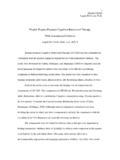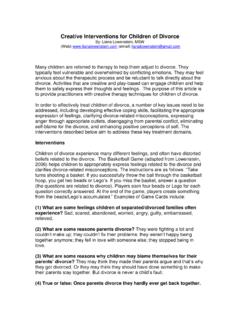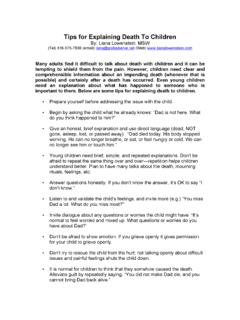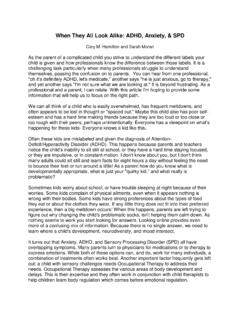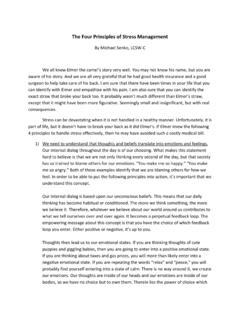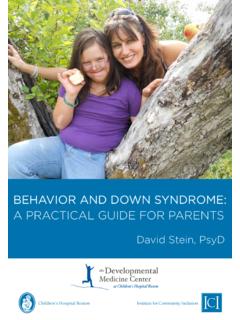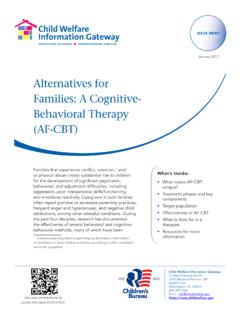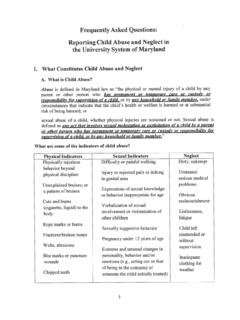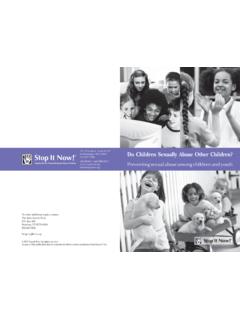Transcription of Understanding and Treating the Sexually Acting …
1 Understanding and Treating the Sexually Acting Out child By: Mistie Barnes, , LPC-S, RPT-S Email: Juliet Fortino, MC, LPC, RPT-S Email: Recently, a parent asked, Is it normal for two-year-olds to touch themselves or does that mean they ve been Sexually abused? This is not an uncommon question from concerned caregivers, especially when children begin to exhibit sexual behaviors. However, to answer this question, it is important to understand child sexual development and the differences in sexual reactivity and sexual offense, which are often confused. Like most trauma responses, sexual reactivity is a normal response to an extreme event the event of being Sexually abused (Dominguez, Nelke, & Perry, 2006). Many clinicians who work with children who have been Sexually abused understand that sexual reactivity can be a part of the process of sexual abuse. However, for those that do not work with these children, sexualized behaviors can be confusing and worrisome.
2 Given this, it is important to be able to distinguish between healthy sexual development in children and the sexual behavior of children who have been Sexually abused. Origins of Sexual Reactivity According to the National Children s Alliance (2009), between January and June of 2009, 129,548 children were served at child Advocacy Centers in the United States. Of these children, 94,689 were served in response to sexual abuse. Children experiencing sexual abuse may experience a number of short- and long-term symptoms, including enuresis and encopresis (Homeyer & Landreth, 1998). Children who have been Sexually abused may also experience a change in appetite, nightmares, aggression, over compliance, age inappropriate knowledge of sexual behaviors, fear of previously unfeared persons (Childhelp, ; Levine & Kline, 2007), problems maintaining peer relationships, genital discomfort, dissociation, regressive behavior, mood swings, and Sexually transmitted diseases (Levine & Kline, 2007).
3 Dominguez, Nelke, and Perry (2006) report that approximately one-third of children who experience sexual abuse may also begin to express Sexually reactive behaviors. Sexual Reactivity Defined Sexual reactivity in children is a common response following sexual abuse (Dominguez et al., 2006). For children who have been Sexually abused, inappropriate sexual behaviors may be a learned form of relating to and communicating with others. However, for those who work with children, it is important to distinguish normal sexual play from Sexually Acting out behaviors. It may be helpful to consider the following characteristics when differentiating between age-appropriate sexual play and sexual reactivity, as these indicators may be indicative of sexual abuse and sexual reactivity (Ruggles, 2009): Is there a history of sexual abuse (suspected or substantiated)? Does the child simulate sex acts with dolls, toys, animals, other children, and adults? Is there knowledge of sex that is more advanced than the child s age level?
4 Are there poor boundaries, particularly related to touch, the child s body, or touching his/her body? Is behavior provocative, flirtatious, or promiscuous with others? Does the child touch other children and adults inappropriately and/or in public (breasts, vagina, groin, buttocks)? Does the child masturbate, self-stimulate, or expose his/her body to others? Are there sexualized themes during play and conversations, including drawing, painting, and playing with dolls and dollhouses? Sexual Offender Defined The question then becomes whether the child who Sexually acts out may be in danger of being considered a sexual perpetrator. Again, it is helpful to consider the following when differentiating between a Sexually reactive child and a juvenile perpetrator. A sexual perpetrator may (Ruggles, 2009) use threats of harm, coercion, or bribery to keep the sexual acts a secret use lies or manipulations to avoid the truth when confronted use violence, weapons, implements, and objects during sexual acts use force or intimidating behaviors Additionally, legislation provides guidelines for defining sexual abuse that serves as a minimal standard for all stages, which identifies sexual abuse as the employment, use, persuasion, inducement, enticement, or coercion of any child to engage in, or assist any other person to engage in, any Sexually explicit conduct or simulation of such conduct for the purpose of producing a visual depiction of such conduct.
5 ( Department of Health and Human Services, 2004, p. 44) Commonly, children who are experiencing sexual reactivity do not engage in the above-listed behaviors. Their sexualized behaviors, while at times involving other individuals, are a response to their own traumatic experience or experiences (Dominguez et al., 2006) therefore distinguishing them from sexual offenders. Sexual Development and Play Sexual development and sexualized play are a natural and healthy process for children. Although all children develop at different rates, there are certain behaviors and experiences that are commonly observed among certain age groups. For instance, babies and toddlers may be observed rubbing their genitals during diaper changes. According to Dunn, Myers-Walls, and Love (2006), children from the ages of birth to two are often very curious about their bodies. At this stage of development, touching and self-stimulation are normal. This experience is calming and soothing, rather than Sexually exciting, as it may be for teens and adults.
6 Children ages two to five years may continue to explore their bodies. At this age, children are learning about privacy, they may be interested in looking at others naked, and they are learning about their different body parts (Dunn et al., 2006). This is a time in childhood when masturbation and sexual play may be heightened. At this stage, caregivers may need to set rules regarding when and where this type of experience is to occur, without creating an atmosphere of shame. For example, the caregiver can say, It feels good to rub your penis/vagina, but this is something that s okay to do in private, like in your bed at nighttime. School-age children, ages six to nine, continue to be curious about their bodies and the bodies of others and may begin sexual play with other children, such as playing Doctor. They may be heard telling other children dirty jokes. Their knowledge of sexual matters continues to expand through this period, and children in this age range may begin to enter the first stages of puberty (Dunn et al.)
7 , 2006). Children within the 10 to 12 age range, the preteen child , begin to have clearer concepts about love, sex, and relationships. Sexual development during this period is extremely active (Dunn et al., 2006) and hormones begin to influence interactions with peers. By the time they have reached adolescence, children are moving deeper into intimacy and relationships. Sexual behaviors become more common, including petting, regular masturbation, and intercourse. However, when a child is Sexually abused, there is a significant disruption to this natural progression (American Academy of Pediatrics, 2005). Sexually Reactive Behaviors in the Therapy Room Children are known to use play to work out their problems, using toys and metaphors to process their experiences and resolve their inner conflicts (Axline, 1964; Axline, 1969; Findling, Bratton, & Henson, 2006; Landreth, 1991; Muro, Ray, Schottelkorb, Smith, & Blanco, 2006; O Conner, 2000). According to Oaklander, children experience much in life they find difficult to express in language, and so they use play to formulate and assimilate what they experience (2001, p.
8 45). When provided with the therapeutic space for creative expression, children may process their experiences in a variety of ways that may be daunting for the unsuspecting clinician. According to Ater (2001), there are several expressive actions a client who has experienced sexual abuse may engage in when working in a creatively friendly therapy room. Dissociative experience: In this form of expression, a client may dissociate from the current experience, as it may become too overwhelming for the child to process with his/her current level of coping skills. This can look like a child is checking out and staring into space for extended periods of time. When the child returns to play, he/she may have little to no memory of the dissociation and may deny certain actions. Nurturing play: Children who have been Sexually abused may express their need for nurturing in the therapy room by utilizing available materials or through interactions with the clinician. They may ask the therapist to nurture them, as well as demonstrate the need to be nurturing to others.
9 Abreaction: Much like adults, processing a traumatic event or events is not a singular experience for children. Therefore, it may take many episodes of talking about, or in a child s language, playing out, the traumatic experience, to increase mastery, control, and healing. Many children recreate or reenact the trauma through their play repeatedly. Perseveration: Perseveration, similar to the catharsis of abreactive processing, involves the repetitive enactment of a traumatic experience. However, instead of increasing mastery and control and moving toward healing, in perseveration, a client may become stuck in his/her reenactment and have difficulty finding a hopeful resolution to the traumatic experience. Sexualized play: Sexualized play may take many forms in the therapy room. Children may engage in abuse-reactive play, whereby the abuse event may be replayed in some form in the therapy room and incorporate the therapist into the play to test the boundaries of the therapeutic relationship.
10 A second form of sexualized play often seen in the therapy room is symbolic sexualized play. In this form of play, children engage in sexualized play as they work to gain mastery, Understanding , and acceptance of their abuse experience. During this form of play, children must learn how to form and maintain relationships with those in the world in a non-sexual manner. A final form of sexualized play that may be seen within the therapy room is reenactment play. During reenactment play, children may reenact the trauma event, both physically and emotionally. The experiences identified by Ater (2006) provide a general and broad base of behaviors that clinicians might experience within the therapy setting. Other, more specific behaviors, that might be experienced may include, but are not limited to abusive or negative nurturing play, often representing the abuse experience drawings as an expressive medium, particularly where parts of the body may be missing or disfigured (eyes, genitals, mouth, hands) aggressive play as a way to gain a sense of power and control in a world that may seem out of control self-stimulation (indirect: squirming in chair / direct.)
